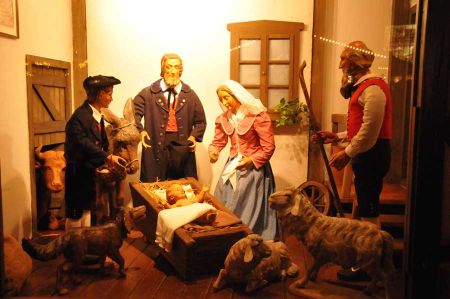Christmas cribs - origin & different characters
- Written by Portal Editor
In the meantime, we have seen Christmas markets in many countries and regions, they all have in common that the Christmas story about the messiahs Jesus occupies an important position at many stands.
Often lovingly built in the centre of a sales booth, there are numerous models for the Christmas story about the birth of the Messiah. This tradition of Christmas cribs with figures and their “home”, which we maintain, goes back to early Christianity internationally, although the depictions of the first centuries only showed the baby Jesus with the two animals ox and donkey. According to the tradition of the Gospel of Luke, the figure of Maria was added in the Middle Ages, the figure of St. Joseph even later. It is interesting too, that there are already around 500 pictorial representations in which the three sages "from the Orient" offer their gifts to the child of God. This is evidenced by illustrations both in the mosaic in Sant’Apollinare Nuovo in Ravenna and in Santa Maria Maggiore in Rome.
Christmas illustration of the Jesuits in Prague from 1562
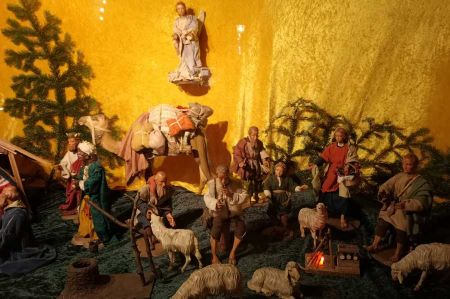 The Christmas depiction made by Jesuits in Prague in 1562 is generally considered the first mention of a crib in today's sense. Following the example of the crib set up in Munich in 1607, such a crib was also built in Innsbruck in 1608 and in Hall in 1609. A Christmas crib in the Benedictine convent in Nonnberg in Salzburg has been occupied since 1615.
The Christmas depiction made by Jesuits in Prague in 1562 is generally considered the first mention of a crib in today's sense. Following the example of the crib set up in Munich in 1607, such a crib was also built in Innsbruck in 1608 and in Hall in 1609. A Christmas crib in the Benedictine convent in Nonnberg in Salzburg has been occupied since 1615.
The Neapolitan cribs, whose heads are full of character, are reminiscent of the masks of the Italian Commedia dell’arte. The scene of the birth of Christ is often embedded in extremely elaborate and detailed street and market scenes, so that the representation of the birth often just appears to be a minor matter. In the Baroque period, many cribs based on the Neapolitan model were created in Austria and in southern Germany.
Under Empress Maria Theresa and Joseph II, Christmas cribs were banned from public buildings, especially the churches, by several bans. Archbishop Hieronymus Franz Josef von Colloredo-Mannsfeld issued a similar ban on November 22, 1784 for the Prince-Bishopric of Salzburg. Only then the Christmas cribs did find their way into the private sphere. This persisted even after the bans were lifted.
Francis of Assisi founder of the representation of the Christmas story
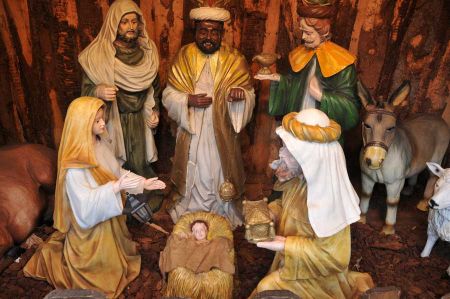 Saint Francis of Assisi is considered to be the founder of the meaningful representation of Christmas events. This may have something to do with the Christkindl, which is widespread in women's monasteries of the 13th and 14th centuries. The worship of the holy place near Bethlehem goes back even further. The church fathers Hieronymus and Justinus as well as the church writer Origen mention a cave on the site in Bethlehem, where Saint Helena had built so-called Church of the Nativity.
Saint Francis of Assisi is considered to be the founder of the meaningful representation of Christmas events. This may have something to do with the Christkindl, which is widespread in women's monasteries of the 13th and 14th centuries. The worship of the holy place near Bethlehem goes back even further. The church fathers Hieronymus and Justinus as well as the church writer Origen mention a cave on the site in Bethlehem, where Saint Helena had built so-called Church of the Nativity.
Although there is nothing to be said about the poverty of the Holy Family in the Christmas gospel, the Bible passage, according to which the child was placed in a place that is normally used for feeding animals, has been interpreted accordingly by the faithful during the centuries. It was conjectured that Jesus was not of a high class, but one of the common people.
Accordingly, late medieval figurative representations of the birth of Christ were already realistic, as can also be seen in the late Romanesque chapel Hocheppan near Bozen from around 1200. A possibly continuous development up to the Christmas crib known today was interrupted by the Reformation. Encouraged by the Council of Trento (1545–1563), the orders of the Jesuits, Servites and Franciscans tried to revive the content of the Bible by means of scenic depictions. Especially Christmas and the passion for Easter were brought closer to the faithful. Boxes with biblical representations were placed in churches and soon became popular in noble circles.
Even the Christmas tree could not displace the cribs
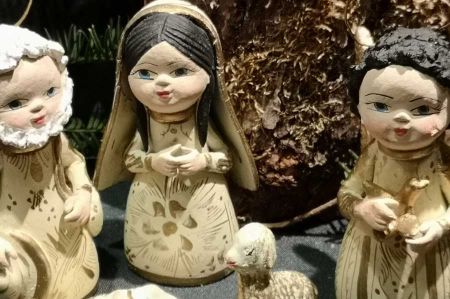 Before the Christmas tree became widespread in the 19th century, the crib was the focus of the Catholic Christmas party. In Protestant Germany, Christmas crib was particularly popular thanks to the work of Gustav Jahn, who had made crib figures by the inmates of the Züllchower institutions. When the serial production of nativity figures from relatively inexpensive materials such as terracotta and papier-mâché began at the end of the 19th century, even less wealthy private individuals were able to buy a nativity scene for their apartment; these figures were correspondingly larger for poorer church communities executed, affordable too.
Before the Christmas tree became widespread in the 19th century, the crib was the focus of the Catholic Christmas party. In Protestant Germany, Christmas crib was particularly popular thanks to the work of Gustav Jahn, who had made crib figures by the inmates of the Züllchower institutions. When the serial production of nativity figures from relatively inexpensive materials such as terracotta and papier-mâché began at the end of the 19th century, even less wealthy private individuals were able to buy a nativity scene for their apartment; these figures were correspondingly larger for poorer church communities executed, affordable too.
To this day, cribs are an integral part of church and especially domestic Christmas decorations and are made and presented in all imaginable artistic styles and materials, and the variety of materials is clearly noticeable.
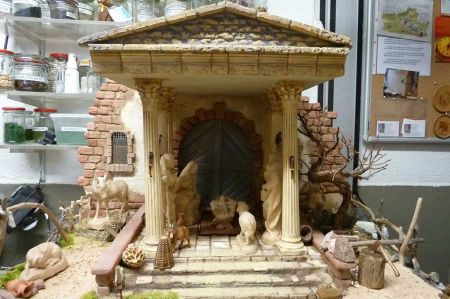 If on the one hand pure natural products are used, on the other hand there is artistically painted porcelain. So are the offers at the stalls of the Christmas markets. It is often clear from the faces of the figures that their origin is clear, that people in many countries choose very different types of people as models for their figures. The presentation of the figures at the Christmas market in Hattingen is very revealing, a small selection in the pictures in the appendix.
If on the one hand pure natural products are used, on the other hand there is artistically painted porcelain. So are the offers at the stalls of the Christmas markets. It is often clear from the faces of the figures that their origin is clear, that people in many countries choose very different types of people as models for their figures. The presentation of the figures at the Christmas market in Hattingen is very revealing, a small selection in the pictures in the appendix.
By the way: Pope Francis acknowledged and recommended the custom of setting up Christmas cribs in private and public areas in 2019 with his own apostolic letter (Admirabile signum).
Please read as well:
Saint Nicolas from Myra - his magical miracles
Advent - fasting period or comtemplatative Pre-Christmas
-
 Christmas Culture from different Countries
Christmas Culture from different Countries
Christmas Culture from different Countries
Christmas Culture from different Countries
-
 Christmas Culture from different Countries
Christmas Culture from different Countries
Christmas Culture from different Countries
Christmas Culture from different Countries
-
 Christmas Culture from different Countries
Christmas Culture from different Countries
Christmas Culture from different Countries
Christmas Culture from different Countries
-
 Christmas Culture from different Countries
Christmas Culture from different Countries
Christmas Culture from different Countries
Christmas Culture from different Countries
-
 Christmas Culture from different Countries
Christmas Culture from different Countries
Christmas Culture from different Countries
Christmas Culture from different Countries
-
 Christmas Culture from different Countries
Christmas Culture from different Countries
Christmas Culture from different Countries
Christmas Culture from different Countries
https://www.alaturka.info/en/culture/religion/4957-christmas-cribs-origin-different-characters?tmpl=component&print=1&layout=default#sigProId5065db7994
